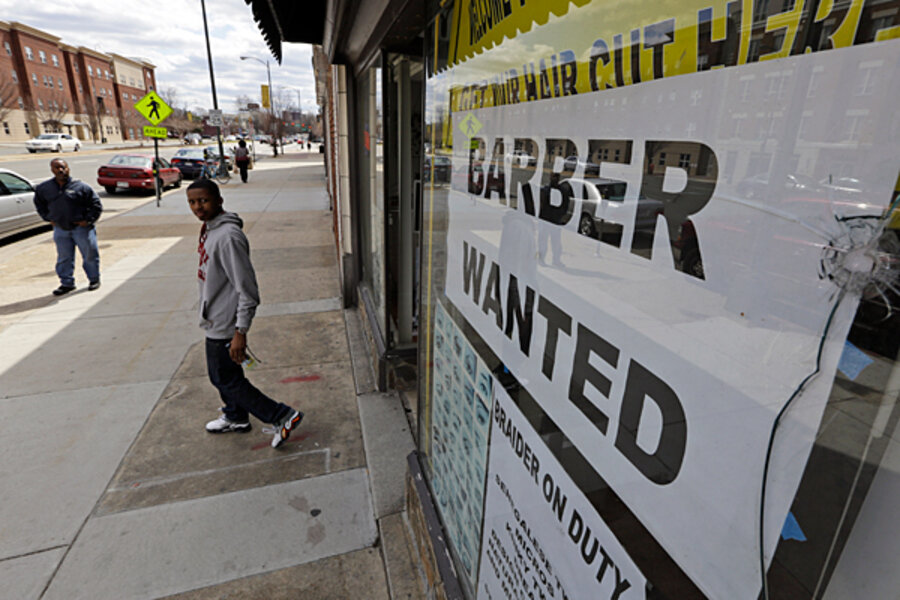Jobs report for March a disappointment. What happened?
Loading...
| New York
March appears to have been a clunker for the economy.
In a surprise to most economists, the economy created 88,000 jobs last month, the Bureau of Labor Statistics (BLS) reports. If that level were to continue, it would imply very slow economic growth.
At the same time, the unemployment rate edged lower, from 7.7 percent to 7.6 percent. But the main reason for the drop was fewer people in the workforce, probably because they could not find jobs.
It was not clear why job growth was so weak after growing by 268,000 in February and 148,000 in January, economists said. There were no high-profile weather events, and the effect of the budget battle in Washington that resulted in sequestration had not really kicked in yet.
“This is just a bad report,” says economist John Canally of LPL Financial in Boston. “You just hope it is a one-off.”
From a policy standpoint, the latest numbers were likely to reinforce the Federal Reserve’s stimulus policy, economists said.
“There had been some talk that maybe the Fed might start to stop being so accommodative,” says John Silvia, chief economist at Wells Fargo in Charlotte, N.C. “This number will temper that view: The Fed’s policies will remain in place.”
Although sequestration, the forced reductions in federal spending, is taking place, it is still too early to see the impact of that policy, economists say.
In the March report, federal government jobs declined by 14,000. Of those, 12,000 were attributed to reductions in the US Postal Service, which were not part of sequestration.
Although some federal agencies announced plans to furlough workers in advance of the actual implementation of sequestration, most are not beginning the reductions in hours until this month.
“We would have seen the effect of sequestration in a reduction of hours worked, but those did not go down,” Mr. Canally says.
The average workweek in terms of hours rose last month by 0.1 hours, to 34.6 hours worked per week, according to the BLS.
The report continues a recurring trend of the last few years, Mr. Silvia says: Businesses are optimistic starting the year, hire lots of workers, and then become more conservative by spring.
“We’ve had this trend of the second quarter starting out weaker for the last five or six years,” he says.
In an analysis released Friday, IHS Global Insight, an economic forecasting firm based in Lexington, Mass., projected that the economy grew by 3.8 percent in the first quarter. But the firm expects only 0.4 percent growth in the second quarter.
One bulwark of the economy for the first three months of the year has been the stock market. In the first quarter, stocks were up about 10 percent.
However, on Friday, investors were unhappy about the jobs report, and there were renewed concerns about Europe and the heightened tensions on the Korean Peninsula. At noon, Eastern time, the Dow Jones Industrial Average was off about 117 points, or about 0.8 percent. At the same time, many investors moved into government bonds. This reduced interest rates to one of their lowest points for the year, with the 10-year treasury note yielding 1.7 percent and the 30-year bond yielding 2.86 percent.
Some analysts anticipate that inflation numbers, which the government will report in the middle of this month, might actually decline because the price of gasoline is down about 30 cents a gallon compared with a year ago.
“We normally see pretty big increases in gasoline prices in March, so this may actually result in some negative numbers,” says Scott Brown, chief economist at Raymond James & Associates in St. Petersburg, Fla.
Normally, lower gas prices would help retailers because consumers would have more disposable income in their pockets.
But last month, according to the BLS, the largest weakness in jobs appears to have been in the retail trade, which lost 24,000 jobs. Within that group on a nonseasonally adjusted basis, clothing and accessory stores said they shed 15,000 jobs, while building and gardening stores lopped off 10,000 jobs.
Some economists wondered if the weakness in that sector was the result of the increase in payroll taxes that went into effect at the beginning of the year.
“There could be kind of a lag impact from the payroll tax,” Mr. Brown says. “Many people don’t look at their pay stubs because they get direct deposit to their checking accounts.”
Economist Jack KIeinhenz of the National Retail Federation (NRF) sees the decline in retail employment as the likely result of several factors. The decline of 10,000 jobs in the building and gardening stores may be related to the tailing off of repairs from superstorm Sandy, which hit the East Coast last fall.
At the same time, he says, the “wretched” weather in March may have diminished the ardor of many consumers.
“The cooler March in some cases probably explains to some extent why clothing did not do so well,” he says.
In addition, retail sales were relatively strong earlier in the year, which may have resulted in retailers postponing layoffs from their holiday ramp-up last year.
“Maybe they just kept more people on the floor,” Mr. Kleinhenz says.
Earlier, the NRF estimated that retail sales would be flat for Easter. Such sales will be reported next week.
The jobs picture was not totally bleak. According to the BLS, professional services (accountants and lawyers, for example) added 51,000 jobs. This category, which includes temp workers, has grown by 533,000 in the past 12 months, the BLS reports.
“Temp-service employment was up, and that’s seen as a leading indicator,” Kleinhenz says.
Jobs in health care grew by 23,000 positions, and construction, reflecting rising home sales, increased by 18,000.







